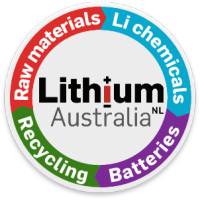VSPC Ltd. (Very Small Particle Co. Ltd.) – a wholly-owned subsidiary of Lithium Australia NL, Perth, Australia – has made significant progress towards improving the energy density of LFP LIB cells by adjusting its proprietary manufacturing processes to incorporate manganese into the cathode active material during production.
Adrian Griffin, managing director of Lithium Australia: “Lithium Australia subsidiary VSPC has made great progress towards improving the production and sustainability of LIBs. Its patented technology has proved successful in the synthesis of high-energy-density LMFP battery cells, which are low-cost and retain the superior safety characteristics associated with LFP LIBs. Indeed, LFP is currently increasing its share of the battery market, and commercialisation of VSPC’s LMFP will provide consumers with the best combination of safety, cost and energy density.
VSPC’s evaluation of low-cost feed materials for LIB production has the potential to make Australia, already the world’s largest lithium producer, a future battery manufacturing hub.”
Improving on LFP performance VSPC has successfully produced LMFP battery cells for testing. These cells, by virtue of their higher voltage, provide greater energy density than that of standard LFP cells.
The discharge curves below are for cells manufactured from VSPC-produced LFP (left) and VSPC-produced LMFP (right). The higher voltage delivery of the LMFP cells results in an energy density increase of up to 25% when compared with the LFP cells. Globally, major LFP cell producers are striving to achieve similar increases in energy density by introducing manganese as a component of their cathode powder.
Safety considerations
LIBs can be divided into a number of categories based on the crystal structure of the cathode materials they contain. Currently, the types of LIBs most commonly used in electric vehicles (‘EVs’) are nickel cobalt manganese (‘NCM’) and nickel cobalt aluminum (‘NCA’). Both NCM and NCA have a spinel (oxide) structure characterised by relatively low-strength chemical bonds. LFP and LMFP, on the other hand, are composed of phosphates (olivine-like crystal structures) with exceptionally high bond strengths. It is this fundamental physical property that results in the superior characteristics (including thermal stability and long service life) of LFP- and LMFP-type LIBs.
Prelude to rapid- charge batteries for transport applications
VSPC plans to develop a rapid-charge battery for transportation applications (see announcement 12 February 2020). Its recent success in testing LMFP cells demonstrates the potential for VSPC’s patented manufacturing process to synthetize LMFP for these applications. Due to its higher energy density, LMFP should reduce the ‘range anxiety’ associated with standard LFP formulations designed for EVs.
Low-cost raw materials
Being able to produce high-performance LIBs without the requirement for nickel or cobalt has many advantages, safety being paramount. Beyond that, the use of common bulk commodities such as manganese, iron and phosphorus reduces costs. Access to much more reliable supply chains is a further advantage.
VSPC’s active programme to reduce costs even further includes its evaluation of industrial waste materials as feed, as well as the production of cathode-material precursors derived from spent LIBs.
The ESG advantage
Commercialisation of LMFP for the production of LIBs would eliminate the requirement for materials from regions in which human rights abuse (including the use of child labour) is rife.
Moreover, as noted, using materials derived from industrial waste materials and spent batteries to create precursors for new LFP- or LMFP- type LIBs can enhance sustainability and reduce supply chain risk.
About Lithium Australia NL
Lithium Australia aims to ensure an ethical and sustainable supply of energy metals to the battery industry (enhancing energy security in the process) by creating a circular battery economy. The recycling of old lithium-ion batteries to new is intrinsic to this plan. While rationalising its portfolio of lithium projects/alliances, the Company continues with R&D on its proprietary extraction processes for the conversion of all lithium silicates (including mine waste), and of unused fines from spodumene processing, to lithium chemicals. From those chemicals, Lithium Australia plans to produce advanced components for the battery industry globally, and for stationary energy storage systems within Australia. By uniting resources and innovation, the Company seeks to vertically integrate lithium extraction, processing and recycling.

